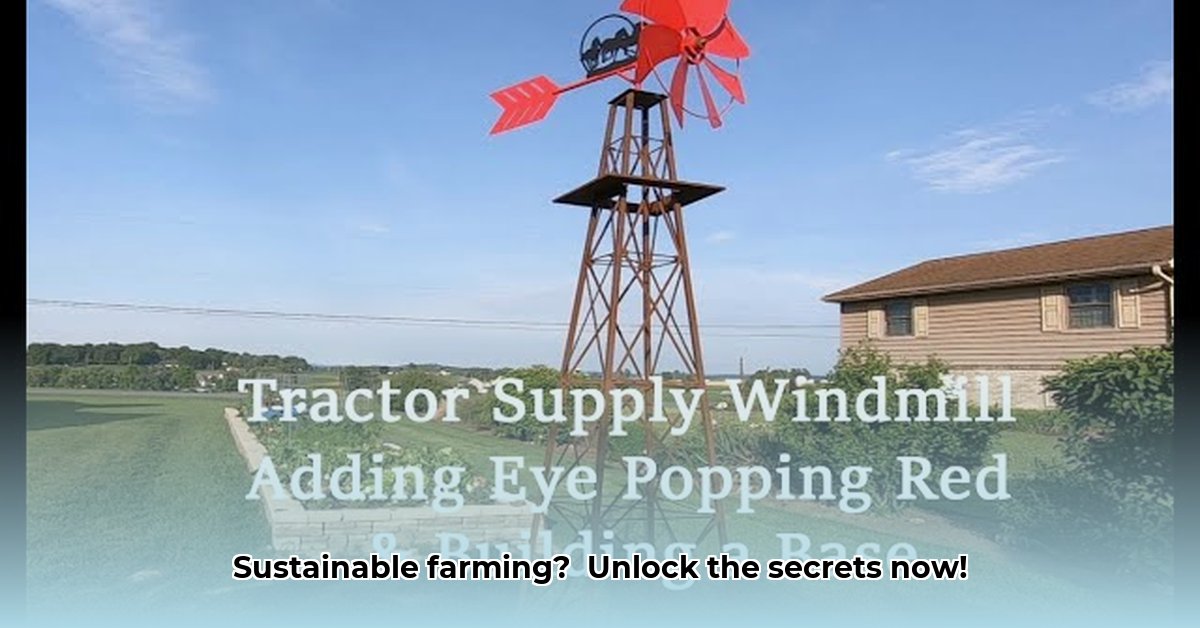
Dairy farming's future hinges on sustainability. This isn't just an ethical choice; it's a smart business decision, impacting profitability and environmental responsibility. This guide explores how "cow windmill tractor supply" companies empower farmers to adopt sustainable practices, boosting efficiency and reducing environmental impact. We'll delve into the equipment, selection process, and real-world examples showcasing the transformative power of sustainable dairy farming. For more information on sustainable equipment, check out this helpful resource.
Cow Windmill Tractor Supply: The Path to Sustainable Dairy Farming
John, a fifth-generation Iowa dairy farmer, faced rising water and energy costs. His old equipment was inefficient, and the strain on his budget and the environment was palpable. Switching to energy-efficient tractors and a wind-powered water system changed everything. His bills dropped, his cows thrived, and his farm’s carbon footprint significantly reduced. His story illustrates the powerful impact of sustainable practices and the right equipment.
The Critical Role of Sustainable Dairy Farming Practices
Sustainable dairy farming is not a trend but a necessity. It centers on water conservation, minimizing the carbon footprint, and prioritizing ethical animal welfare. These practices directly translate to financial benefits. Lower water bills directly improve profitability. Reducing carbon emissions shows environmental responsibility and may help mitigate future regulatory costs. Moreover, happier, healthier cows produce more milk, boosting yields.
"Sustainable practices are no longer optional; they are a fundamental aspect of long-term farming viability," says Dr. Emily Carter, Agricultural Economist at Purdue University. "Integrating them not only benefits the environment but leads to significant cost savings and improved operational efficiency." This demonstrates the convergence of economic and environmental benefit.
Leveraging Cow Windmill Tractor Supply for Greener Farming
"Cow windmill tractor supply" companies act as crucial partners in this sustainability transition. They provide specialized equipment, enabling farmers to adopt sustainable practices. Energy-efficient tractors significantly reduce fuel consumption and emissions. Windmills, tapping into renewable energy, power water pumps, lowering reliance on fossil fuels. Precision irrigation ensures water is precisely delivered where it's needed, minimizing waste. This holistic approach reduces expenses and environmental impact.
Exploring Sustainable Equipment Options: A Detailed Review
Let's examine available equipment and their environmental benefits:
1. Energy-Efficient Tractors: These tractors are designed for maximum fuel efficiency, minimizing fuel consumption and greenhouse gas emissions. Look for features like advanced fuel management systems, optimized engine designs, and automatic idle shutdown.
2. Windmills (Wind Turbines): These harness wind energy to power water pumps, a significant step toward renewable energy adoption. Factors to consider include wind resource assessment, turbine capacity, and maintenance requirements.
3. Precision Irrigation Systems: These systems deliver water directly to plant roots, reducing water waste and improving water-use efficiency. Drip irrigation and micro-sprinklers are particularly effective in conserving water.
4. Solar-Powered Equipment: Solar panels power various farm operations, diversifying energy sources and reducing dependence on the grid. Consider solar-powered pumps, electric fencing, and lighting systems.
Selecting the Right Supplier: A Critical Step
Choosing the right supplier is vital. Seek companies demonstrating a strong commitment to sustainability. Look for suppliers offering a wide range of sustainable equipment, providing support and resources, and actively promoting environmentally friendly farming practices. Read reviews, compare prices, and thoroughly investigate their sustainability credentials. A reliable supplier will act as a knowledgeable partner during this transition.
A Step-by-Step Guide to Equipment Selection
Making informed equipment choices is an investment in your farm's future.
Step 1: Assess Farm Needs: Evaluate farm size, terrain, climate, and crop types to determine specific equipment requirements.
Step 2: Define a Realistic Budget: Set a budget encompassing initial equipment costs, installation, and long-term maintenance.
Step 3: Evaluate Specific Needs: Consider factors like terrain, climate, and crop type. For example, undulating terrain may necessitate stronger tractors.
Step 4: Account for Maintenance Costs: Factor in regular servicing and repairs, as well as the lifespan of the equipment.
Step 5: Prioritize Sustainability: Prioritize equipment directly contributing to your sustainability goals, such as renewable energy systems or water-efficient irrigation. This prioritization will lead to long-term benefits.
Case Studies: Proven Success in Sustainable Dairy Farming
Numerous farms worldwide have successfully integrated sustainable practices. Research successful implementations in your region to learn from their experiences. Consider studying similar farm operations facing similar challenges and observing their approaches and results. Their journeys offer invaluable insights into overcoming hurdles and achieving success.
Equipment Comparison: Weighing the Pros and Cons
| Equipment Type | Pros | Cons |
|---|---|---|
| Energy-efficient Tractors | Reduced fuel costs, lower emissions, increased efficiency | Higher initial cost |
| Windmills | Renewable energy, reduced reliance on grid, cost savings | Intermittent wind power, initial investment costs |
| Precision Irrigation | Water conservation, higher crop yields, efficient nutrient delivery | Higher upfront cost, requires technical expertise |
| Solar-powered Equipment | Clean energy, reduced electricity bills, low maintenance | High initial costs, dependence on sunlight, space requirements |
Remember, adopting sustainable practices is a holistic journey, not a quick fix. A reliable "cow windmill tractor supply" company plays a crucial role in providing the tools you need to achieve your sustainability goals. Your future success depends on careful planning and the right equipment choices.